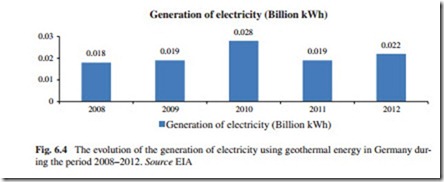Germany
In Germany, geothermal power generation is done through the use of binary cycle technology. Electricity from geothermal sources is set to soar in Germany—and all thanks to a law that has made drilling wells deep enough to hit the hot-temperature water, which is needed to produce electricity, financially viable. Less than
0.4 % of Germany’s total primary energy supply came from geothermal sources in 2004. But after a renewable energy law that introduced a tariff scheme of €0.15 kWh for electricity produced from geothermal sources came into effect that year, a construction boom was sparked and the new power plants are now starting to come online. “Geothermal sources could supply Germany’s electricity needs 600 times over,” Werner Bussmann, CEO of the German Geothermal Association, told www.RenewableEnergyWorld.com. He said “special, cost-effective technol- ogy allowed energy to be extracted from geothermal reservoirs containing low- to moderate-temperature water that are so typical of Germany”.
Innovative technology is important because Germany, unlike countries such as Iceland, Italy, or Indonesia, does not have volcanic activity or the associated dry steam reservoirs that can be used to produce electricity directly. “Geothermal electricity has the advantage of being available 24 h a day, 8,000 h a year, and this makes it a great source of base load power,” Bussmann said. He predicted that Germany could be generating several thousands of megawatts of electricity from geothermal sources in a couple of decades. There are already four small geother- mal power plants successfully operating in Germany, albeit supplying only a tiny amount of electricity.
The first pioneer geothermal power plant to start operating in Germany is situated in Neustadt-Glewe in the Northeastern part of the country. The 230 kW combined electricity and heat power plant started up in 2003 and extracts water with a temperature of 97 °C from a well 2,250 m under the ground. It supplies 1,300 households with heat and a further 500 households with electricity. Other power plants now operating are the 3.5-MW plant at Unterhaching close to Munich, in Bavaria, which supplies 20,000 households with electricity and heat as well as Unterhaching, which is the first geothermal plant in Germany to use the “Kalina” technology that allows energy to be extracted from water of low to moderate tem- peratures. At that plant, water is extracted at a temperature of 122 °C from a well 3,500 m deep at a rate of 150 l/s. Another 2.5 MW plant in Landau taps water of 150 °C that is located 3,000 m beneath the ground. Finally, a €17 million 550-kW power plant is now operating in Bruchsal. The power plant extracts water at temperatures of 128 °C from a well 2,500 m deep in order to generate electricity for 1,000 households.
Most geothermal power plants—some as big as 8–10 MW—are operating in Sauerlach, Dürrnhaar, Riedstadt, Speyer, Gross Schoenebeck, and Mauerstetten. And looking 3–5 years ahead, there could be more than a hundred of geothermal power plants. Now, about 150 geothermal power plant projects are in the pipeline representing an investment of €4 billion, according to the German government. Just how soon these geothermal power plants will be built, however, depends on whether there is enough drilling equipment available to dig deep enough to hit the hot water needed for electricity generation. At the moment, a shortage of drilling equipment is pushing up the cost for constructing a geothermal power plant.
Since November 2003, a 0.2-MWe pilot power plant using this process is exploited at Neustadt-Glewe and another 20 MWe (four or five power plants) is currently in the planning and construction stage, chiefly in Southern Bavaria. The most advanced project is the one in Unterhaching. This small city, located in the Southwest of Munich, has a 122 °C hot water deposit at a depth of 3,446 m depth with a mean flow rate of 150 l/s. The system consists of a 41-MW CHP plant that could be able to develop an electrical capacity of 3.5–4 MWe (Antics and Scanner 2007). In 2011, Germany had 8 MW of geothermal energy installed capacity.
6.5.1 Generation of Electricity Using Geothermal Energy
The evolution of the generation of electricity using geothermal energy in Germany during the period 2008–2012 is shown in Fig. 6.4.
According to Fig. 6.4, the generation of electricity in Germany during the period 2008–2012 using geothermal energy increased 22.2 %. It is expected that
the use of this type of energy source for the generation of electricity will continue to be part of the energy mix of Germany during the coming years.
